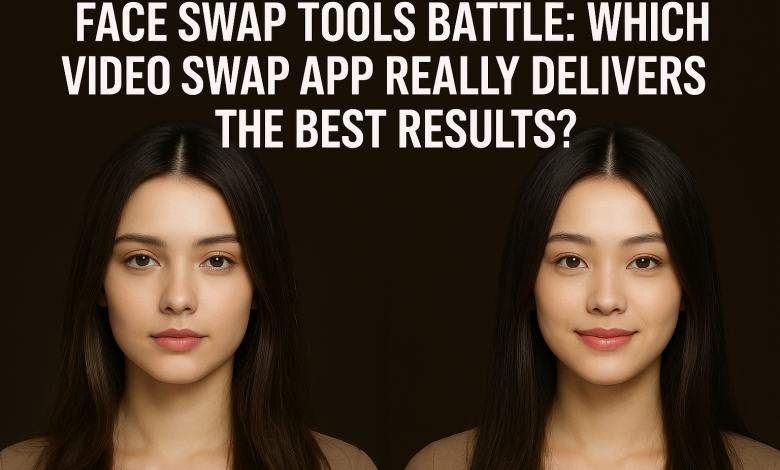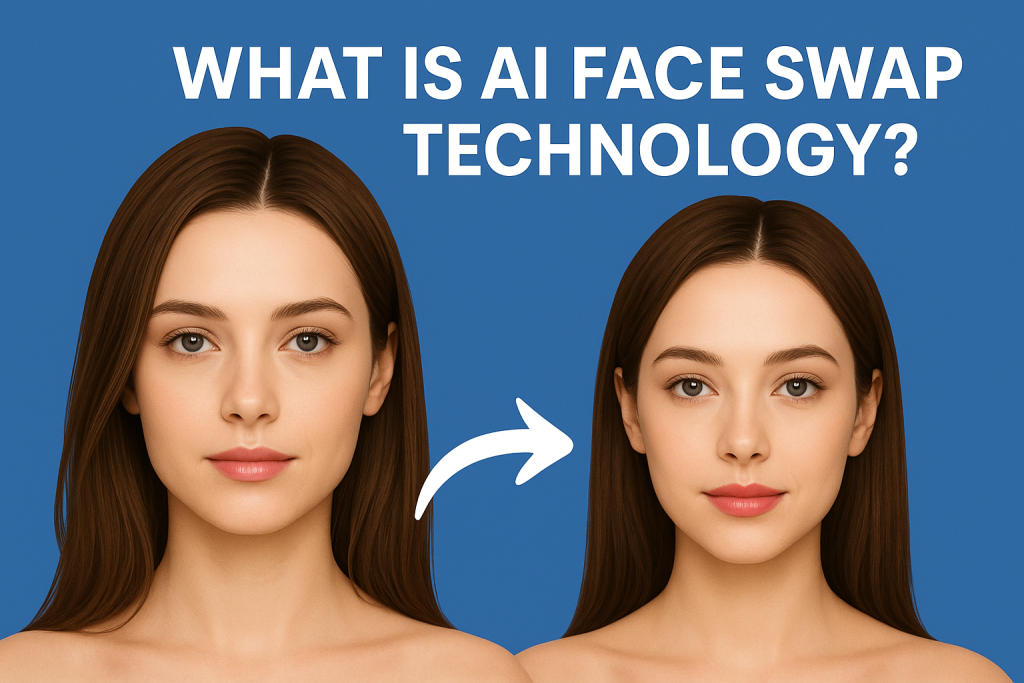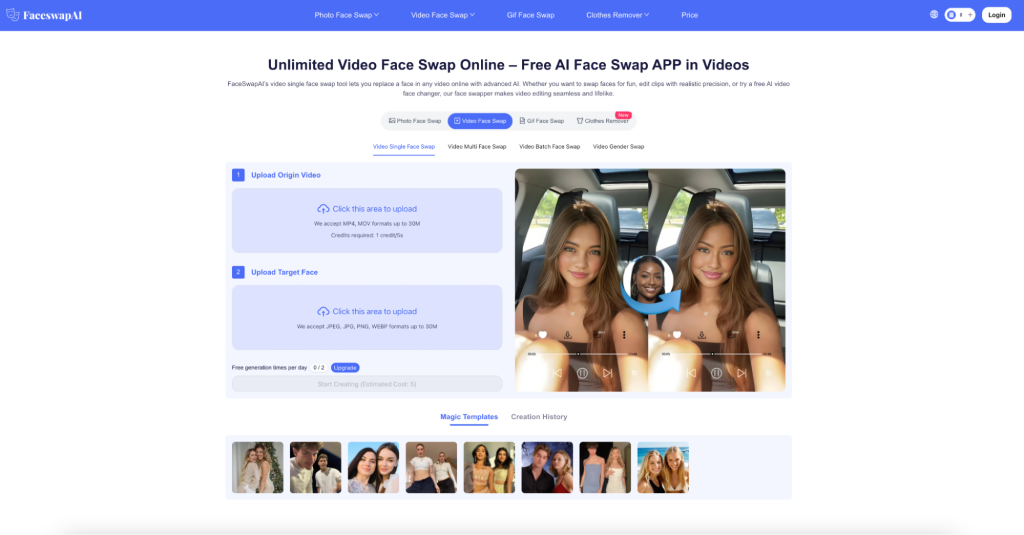
In a world where we’re constantly bombarded with flashy visuals, it’s getting harder than ever to cut through the noise. From a social media clip going viral to some slick marketing video, creators are on a never-ending quest to come up with the next big thing that’ll get their content shared – and shared big time.
Enter AI face swap technology, a tool that’s gone from niche curiosity to mainstream magic for creative expression. But as the market gets flooded with options, the question becomes: which app can deliver truly seamless, super realistic results? This is the ultimate video face swap app battle, where we dissect, test, and score the leading contenders to find the undisputed champion of realism. We also look deeply into FaceSwapAI and why it wins the battle.
New Era of Digital Transformation with Face Swap
AI video face swap is more than just a fun trick; it’s a game-changer for video content creation. It allows one person to create clips that once required a team of VFX artists. For creators, it opens up new formats for storytelling and parody. For marketers, this is an exciting new way to tailor ads to individual tastes and come up with campaigns that people won’t soon forget. And as we go through this digital revolution, the way we think about how people see themselves, how well content performs, and what even counts as ‘media’ is all getting turned upside down. To take this digital revolution a step further, see this deep dive on the Best AI Video Translation Tools of 2026 for creators looking to expand their content globally.
What is Video Face Swapping and Why Does Realism Matter?
Video face swap uses AI to pick out a face in a video and swap it out for a face from a photo or video that someone put in themselves. The AI basically maps out the new face using things like facial features, expressions, and head movements – so it looks pretty realistic.
Realism is the holy grail because it determines whether the final product is a piece of video content or a comical failure. A good swap keeps the viewer immersed, a bad one shatters it instantly.
For Content Creators, Users, and Viral Content
The difference between a good and great face swap can be the difference between a forgotten clip and a viral sensation. For a social media content creator, a realistic swap can boost their work, drive engagement, and growth. For a brand using this tech in their advertising, realism builds credibility and makes the message more impactful. For the casual user, it’s about creating something shareable and impressive. The stakes are high because in the digital world, authenticity – even when artificially generated – is key.
What Makes a Video Face Swap Truly Believable?
A good face swap is a complex orchestration of multiple technical and artistic elements. It’s not just about pasting one face onto another; it’s about creating a seamless blend that tricks the human eye. Understanding these core components is key to evaluating any AI Face Swap tool.
Core Elements of a Realistic Face Swap
The AI’s capacity to manage a symphony of visual data is necessary for a truly realistic outcome. This covers everything, from the resolution of the original video to the minute changes in a person’s facial expression. The best apps use complex algorithms to fully integrate the new face into the scene, going beyond a simple overlay.
Facial Feature Integration & Blending:
The first sign of a fake swap is a hard, visible edge where the new face meets the original head and neck. Elite AI models excel at feathering these edges, creating a smooth transition that accounts for jawline shape, cheek structure, and even fine hair. The alignment of key features like eyes, nose, and mouth must be perfect in every frame.
Skin Tone & Texture Matching:
Human skin is not a single, flat hue. It has intricate textures, pores, imperfections, and minute tone changes. In order to create a blended texture and tone that appears natural under the particular conditions of the scene, a top-tier face-swapping tool must analyse the skin in both the source photo and the target video.
Lighting & Shadow Consistency:
Perhaps the hardest part of realism is this. The AI needs to comprehend the original video’s lighting’s direction, colour, and intensity. The new face must then be re-rendered with highlights and shadows that precisely match the surroundings. The shadows on the swapped face must change and deepen when a character turns their head away from a light source.
Expression & Emotion Mimicry:
A face is a canvas for emotion; it is never static. The expressions from the original performance, such as a subtle smirk, a raised eyebrow, or the crinkling around the eyes during a genuine smile, must be faithfully transferred onto the new face in a realistic photo face swap. If this isn’t done, the illusion is instantly broken by a robotic, “dead-eyed” effect.
The Contenders: Top Video Face Swap Apps Under the Microscope
Each app in the market for AI face swap tools offers a different combination of features, usability, and quality. To compare them, we looked at some of the most well-liked and promising platforms.
DeepSwap.ai:
DeepSwap is often regarded as a professional-grade tool and emphasises realistic, high-fidelity outputs. Because of its powerful AI, which can handle complex videos, including movie clips and scenes with multiple faces, it has become a go-to for serious content creators.
Reface:
Face swapping gained popularity on social media as a result of Reface. Any user can easily create entertaining, shareable videos in a matter of seconds thanks to its user-friendly mobile interface and extensive template library. It prioritises entertainment and speed over realistic filmmaking.
Vidnoz AI:
Vidnoz belongs to a more recent generation of AI tools that offer face swapping as a feature within a wider range of AI video creation services, including AI avatars and text-to-video. This integrated approach will appeal to users looking for a one-stop shop for their video content needs.
Remaker AI:
Remaker AI’s dedication to quality has drawn notice. It is a great option for people who value a polished final product for their images and videos since it seeks to give users high-resolution face swaps that maintain clarity and detail.
Pica AI & EaseMate AI:
These and other emerging platforms are constantly pushing the envelope, often introducing novel features or refining specific aspects of the face-swapping process. They represent the vibrant and rapidly evolving nature of the AI creator tool market, keeping the established players on their toes.
FaceswapAI
FaceSwapAI brings together world-class AI tools and a user-friendly interface to give you one of the most powerful face swap options on the market. Its got all the bases covered – from photos and videos to GIFs, it can swap faces single or multiple times over, do a batch process, and even do a simple gender swap or clothes removal – all in one slick tool. Not to mention whether you’re whipping up a quick meme or crafting a high-end video edit, FaceSwapAI delivers stunning results with a bare minimum of fuss and bother. To top it off, with its seamless blending, the software is fast, reliable and a no-brainer for creatives of all levels – and you can even give it a spin with a free daily trial.
The Ultimate Criteria For Face Swap Apps
We put these tools through a battery of rigorous tests, each intended to examine a distinct aspect of realism, to go beyond marketing claims. Our objective was to determine which application consistently produced the most convincing outcomes in a variety of difficult situations.
The Face Swap App Criteria
We went beyond the marketing hype and put these tools through a series of tests, each designed to test a specific aspect of realism. We wanted to see which app produced the most realistic results across the board.
How We Tested for Realism
We used a set of standard source images and target videos for our tests. The videos included: a well-lit interview clip, a dynamic action scene with fast head movement, and a subtly lit dramatic scene with nuanced expressions. Each output was scored against the following criteria.
Test 1: Facial Feature Blending & Consistency ( mouth, nose, eyes)
We looked at the edges of the swapped face for artifacts and the geometric consistency of the facial features as the head moved. Top performers blended seamlessly, while weaker apps had a slight “floating” effect or distorted features during motion.
Test 2: Skin Color & Texture Cohesion Across Different Lighting
This test showed big differences. The best apps adapt the skin to the light color and temperature. Others struggled, leaving the swapped face looking washed out, over-saturated or with a texture that didn’t match the surrounding skin.
Test 3: Shadow & Highlight Adaptation (Challenging Scenes Adaptation)
Using our dynamic clips, we tested how well the AI re-rendered the lighting. The winners in this category had shadows that fell naturally across the contours of the new face, matching the original scene’s light sources.
Test 4: Expression & Emotion – How Well Can The AI Transfer Them?
You can bet we gave the AI a close look at how well its micro-expressions lined up with the original actor’s – and it did a pretty good job. They were able to pick up on those tiny details, like a brow furrowing or lips tightening, which kept the emotional feel of the performance spot on.
Test 5: Lip Sync – Can The AI Get It Right Every Time?
We’d put it to the test in a dialogue-heavy scene – could the AI get the lip sync just right? Not too shabby – most of the top tools had it pretty much spot on, but the absolute top performers delivered a lip sync that was nearly indistinguishable from the real thing.
Test 6: Head Pose & Movement – Can the AI Keep Up?
This next test put the AI’s 3D mapping skills to the test. How well would it do when things started moving quickly – like when someone turns their head or tilts it? The good ones kept the face and head locked in perfect sync, even when things got crazy. The lesser ones showed a bit of lag or a wonky perspective here and there.
Test 7: Output Quality & Resolution – Does the App Deliver High Quality?
Time to check out the finished video – how clear and detailed was it? Some of the high-end apps really pulled out all the stops – we’re talking 4K HD or even higher. But the mobile-focused apps often had to compress the video to make it playable on lower-end hardware, which was a bummer for detail. Oh, and let’s not forget – a nice big watermark is a major turn-off for pros.
Test 8: Swapping Two Faces – Can The AI Handle It?
For our final test, we threw the biggest challenge at the AI: a 2-person video with both faces swapped out at the same time. This is a real brain-buster for any app – and only a handful of them were able to pull it off without a drop in quality or realism.
Why FaceSwapAI.tech stood out (smooth expressions + realistic output)
The digital landscape is pretty darn crowded with tools that claim to deliver top-notch facial recognition and augmentation, but FaceSwap.tech has really risen to the top of the heap when it comes to real facial recognition tech. It’s gotten to the top largely because of its uncanny ability to produce smooth expressions that look really, really real – and it’s set some pretty high new standards in the process – and that’s really caught the eye of both the people building this tech and the folks who actually use it.
Enhanced Naturalism Through Smooth Expressions
One of the things that really stands out about FaceSwap.tech is how convincing the facial expressions are – and that’s down to some seriously smart algorithms that really dig deep to get the tiny little details of how people move their faces just right. Unlike a lot of other tools out there, which end up looking pretty forced and stiff, FaceSwap does a seriously good job of capturing the fluidity and nuance of a real human expression – and that makes a huge difference when you’re dealing with something that’s supposed to be as realistic as this. The way it just seamlessly switches between expressions, not to mention making them look and feel so authentic, not only makes this tech feel way more real than it has any right to be, but it also makes for a way more engaging and a way more satisfying user experience.
Advanced Algorithmic Precision for Realistic Output
The basis of FaceSwapAI is realism. tech’s offering, and it is that commitment to accuracy that sets it apart. Through state-of-the-art machine learning technology, the platform can generate stunningly realistic facial swaps. Increased fidelity in skin texture, shadowing, and overall imager realism results in outputs that cannot be differentiated from photographs. This level of detail makes it a valuable tool not only for personal use and entertainment but also to apply in professional work in film, advertising, or interactive media.
User-Focused Innovation
FaceSwapAI.tech’s emphasis on user-centric innovation is what makes it even more unique. Because of the platform’s user-friendly interface, even non-experts can produce results of a professional calibre. This accessibility doesn’t compromise quality; on the contrary, it gives a wider audience the ability to produce and distribute realistic content.
Which Face Swap App Truly Leads the Future of Realism?
Rather, when everything was said and done (well, tested), one stood above the rest. Reface is perfect for quick, fun, easy face swaps and super realistic face swapping. However, rapid transformations are the trade-off for high fidelity realism. When it comes to realistic results for your video content, whether you are a content creator or marketer, or an average Joe looking for realism, then FaceSwapai wins. Its AI does dynamic lighting, emotion transfer, and facial integration better than its competitors, resulting in clips that walk the line between real and fake. Newer options like Remaker AI show some promise in high-res output, but DeepSwap’s heft from the crucible of online imitation has the leg up when it comes to handling complex video wrangling.
Select your app based on your objectives. For a quick meme to share with friends, a mobile-first option is perfect. But whether you’re making marketing videos, adding high-quality clips to your social media, or just exploring the AI frontier, it’s imperative to invest in a tool that prioritises realism. Thanks to AI’s quick development, the goal of perfect digital impersonation is closer than ever, and for the time being, the most advanced tools are those that can use light, shadow, and emotion.






